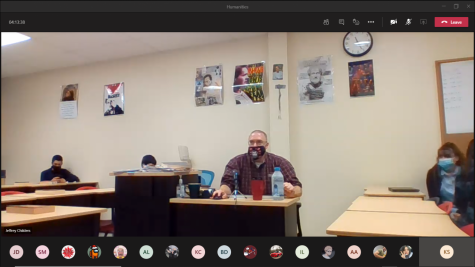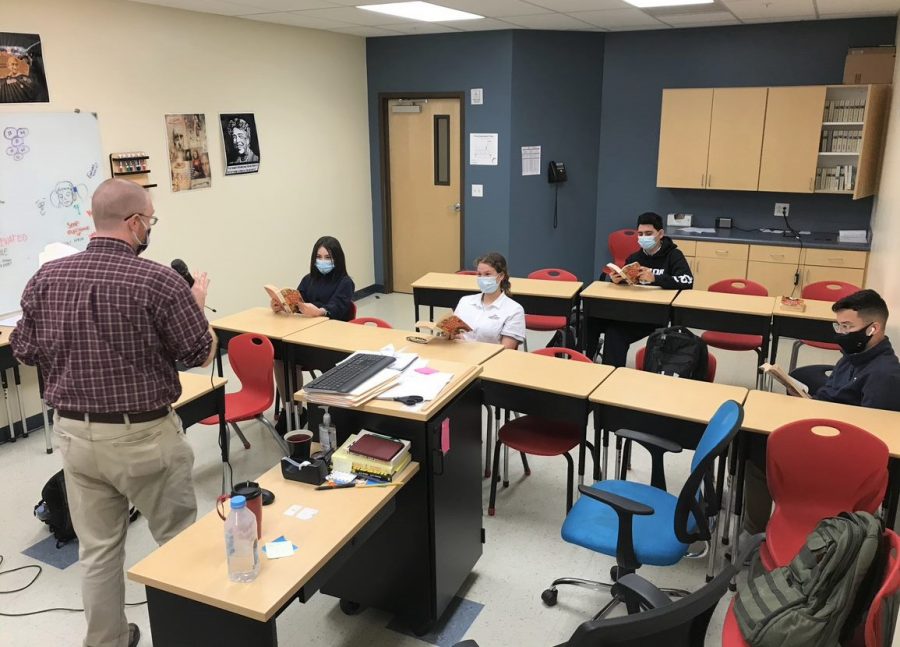Teachers Try to Make the Most of the Spring Semester
Simultaneously teaching virtual and in person students creates new challenges for teachers.
Social studies teacher Mr. Jeffrey Childers teaches his sixth period humanities class Photo Credit: Photo by Freshman Matthew Mackivitch
February 22, 2021
COVID-19 turned the entire 2020-2021 school year upside down, leaving teachers and students scrambling to piece together an academically productive year. Trying to teach during a pandemic is no small task, but teachers are doing what they can.
Practical Applications
Even before COVID-19, for this generation, technology has always had a place in the classroom. Students in high school must complete and submit assignments online and many use programs such as PowerUp or Khan Academy to help reinforce concepts taught by teachers. Now, during a largely virtual school year, technology is often the only way to connect students and teachers, making relationships between teachers and students strange.
“It’s easy to have a relationship or engage with a student when you’re with them in front of them every day, but when you have online kids that are hiding behind a computer screen that don’t really want to interact, or, you know, just are typically a little bit more quiet,” Writing teacher Mrs. Caylee Kitchen said. “It’s kind of a struggle, I wish I could just like reach out to my online kids and hug them, but I can’t.”
A heavier reliance on technology may pose an issue for trying to forge a relationship with students, but there are some practical advantages to virtual learning.
“There have been advantages because I have more time, I don’t spend time commuting back and forth. So that is definitely one of the advantages,” Algebra II teacher Ms. Mona Kaldas shared. “That allows me more time so I can prepare better and have more time to grade and write comments. And because now I answer lots of emails and messages.”
Additionally, virtual assignments and grading gives students more flexibility in their own schedules, allowing teachers and students more opportunities to learn outside of class or learn to manage their own time, but having this flexibility does not work with everyone.
“They can work at their own pace, and complete tasks and assignments, maybe just at a bit of a faster rate,” Research teacher Ms. Jacquelyn Pileckas said. “And if they have questions, I think that some people do struggle with online learning because they don’t feel supported, I guess, in the same way as they do when the teacher is in the room with them.”
Student Attitudes
While teachers oversee providing students with work and instruction, it is often the students that make or break a class. For virtual and in person students, this year has offered a slew of new distractions, which can cause issues with student engagement. Digital Design, Yearbook, and Accounting teacher Ms. Holly Schmitt described her experience with student engagement.
Kaldas found this was no different than being in person, this year however makes it harder to address when students are not engaged. This is especially true since Kaldas teaches all her students virtually.
“I (do not) think this would be any different from being in a classroom situation, because usually, you would have the same kinds of problems,” Kaldas said. “The students will be either talking or on their cell phone, or they want to go to the bathroom. But if I’m online sometimes it is hard to tell who’s listening and who’s not, unless I go and check with each and every one of them.”
Kaldas also explained some of the other effects of being a fully virtual teacher, mainly how it has changed her relationship with the school community.
“I’m really isolated from the school environment, and from other teachers,” Kaldas explained. “So this really has a negative effect on me as an individual, because you need the help and the support of the team that’s in school and the other teachers, the team, and so on.”
Schmitt found that her expectations of support from the school were not met. Instead, she had to find other ways to help herself and her students make it through this year.
“I was expecting more training and support from administration,” Schmitt said. “Not having the training, I’ve had to teach myself the new technology, research new technology, and through teacher support groups on social media, I’ve been making things work.”
Freshman Alex Tillman found that some of his teachers did not seem to be struggling significantly, instead he saw times when virtual and in person students were able to connect.
“When it comes to either being an in-person student or an online student, I’ve seen a lot of times where both an in person and online students can collaborate or can participate more frequently with one another,” Tillman said.

Virtual versus In Person
Many students at FCUS made the decision to work from home, but after winter break the school has seen a sharp increase in the number of students learning in person. The difference in learning in person and virtual is stark, some teachers have found this difference to be amplified depending on the subject.
“I’m basically switching all the learning curriculums into an online environment and switching all the activities that we were used to doing to online especially,” Engineering teacher Mr. Evanan Bracho said. “Today, in engineering, which is a subject with a lot of hands-on activity, changing all of that into virtual environment has been one of the most difficult things.”
Sometimes this difference can hinder the education of students, despite a teacher’s best efforts. Students in person just have access to more resources that make it difficult to create equal working environments for those at home and those at school.
“They have objects, they have devices, they have apparatus, a lot of equipment, basically, technological equipment related to engineering,” Bracho explained. “For example, we have a 3D printer that students have been able to work with.”
Other classes have found that many students are struggling with feeling connected to the school and their peers, online learning does not provide the same social environment that in person learning does, but Pileckas has taken steps to try to correct this.
“I think that a lot of people really miss the camaraderie of having their friends sitting right next to them,” Pileckas shared. “So I’ve been trying to utilize a lot of breakout rooms on zoom and get people into pairs and groups with minimal teacher interactions.”
Pileckas also found that this year offered new directions for learning and is introducing new projects to help improve student attitudes while having students learn the subject.
“So, having this technology available is really great and it’s forcing students to look at resources that they otherwise wouldn’t have looked at,” Piceckas shared. “For their upcoming project my students are going to have to interview a member in the community. And that’s something we might not have necessarily done if we weren’t socially distanced right now.”
Freshman Erin Foley’s experience with teachers was similar, but she did find that some teachers struggled to adapt to teaching both in person and virtual students, making it harder for those online to actively participate in class.
“Some teachers in the classrooms don’t really ask or participate with the students online,” Foley explained. “So, any of the teachers who are asking for students’ online feedback and to participate in class and asking them questions, have a better time of getting the results and understanding online students understand the concept better.”
Yet, Foley still found that she was understanding of the plight teachers are currently facing, and knows they are trying their best to overcome the situation.
“Right now, I don’t have anything that I would (change) because I understand that they are trying to figure it out along with the students, the whole online learning along with in class learning,” Foley said. “I believe that everything, that all the actions and steps that they’re taking to help with online along with us, they are doing a great job.”
The most important thing that Kaldas wanted to stress to students about this out of the ordinary year is that regarding academics, this year is not really all that different.
“You still have your teacher, the same number of hours, or even sometimes after school as well,” Kaldas shared. “You can communicate, if you don’t understand something. If you’re missing something, you can talk to them. So, we’re just doing it differently, but it’s the same thing.”
Ultimately, Pileckas wants all students to take care of themselves in such a strange time, and to make sure they are mindful of their mental health. She explained how she is trying to give students less homework, so they have time to focus on themselves.
“I want to make sure that they have as much time as possible at home to take care of their mental health too,” Pileckas explained. “And even with my virtual students, I’m just like, let me know if you’re struggling and what I can do to help. As long as there’s communication there. I think myself and all of my coworkers would agree that we’re here to help you guys. Just tell us what’s going on.”



